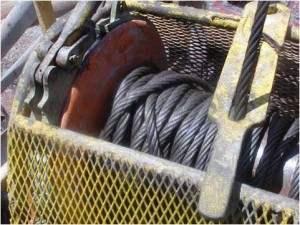Crane standards, inspections on BSEE, Coast Guard agendas
By Katie Mazerov, contributing editor
The US Bureau of Safety and Environmental Enforcement (BSEE) may seek updated standards regarding offshore pedestal-mounted cranes, and a US Coast Guard (USCG) ruling that would allow more third-party entities to inspect cranes on floating rigs and mobile offshore drilling units (MODUs) is in the clearance process, regulatory officials announced during a panel session at the IADC Lifting and Mechanical Handling Conference & Exhibition, 18-19 July in Lafayette, La.
BSEE currently has no lifting regulations in the pipeline, but next year the agency will consider seeking updates to API Spec 2C regarding requirements for the design, construction and testing of new offshore pedestal-mounted cranes, said Joe Levine, senior engineer for BSEE. Mr Levine presented a regulatory update along with Ken Smith, assistant division chief and general engineer for the Office of Vessel & Facility Operating Standards, USCG, and Alexander Novas, compliance assistance specialist in the OSHA Baton Rouge bureau.

The speakers reviewed the roles of their respective agencies in enforcing health and safety standards for the oil and gas industry and emphasized the collaborative efforts they are undertaking to provide input in developing industry standards.
“As regulators, it is extremely important for us to be party to the standards development process,” Mr Smith said. “Not only does it allow us to put a finger on the pulse of what industry is thinking, it allows us to see where consensus lies and what areas are difficult to help us formulate regulations.”
BSEE’s 2012 agenda includes roll-out of SEMS II (Safety and Environmental Management System) this fall, which will modify SEMS I with six new provisions. The agency also will issue a final ruling on drilling safety and enhanced regulations regarding blowout preventers (BOPs), Mr Levine noted.
BSEE has jurisdiction over cranes and material handling on fixed platforms. Federal crane regulations for fixed facilities are outlined in 30 CFR (Code of Federal Regulations) 250.108, which mandates that all cranes have safety devices and that records relating to crane design and construction, training of all personnel involved in crane operations, and inspection, testing and maintenance be kept for at least four years. Incidents must be reported within 15 days.
Lift-related Safety Alerts
Between June 2003 and June 2010, the agency (under the previous Minerals Management Service) issued nine lift-related safety alerts (non-binding guidance) and conducted six lifting-related investigations. “A lot of management program themes permeated the safety alerts, such as training, management-of-change procedures, job safety analyses, inspection and maintenance and safe work practices,” Mr Levine said. “These are the issues that keep coming up over and over, not only from industry’s view of things, but from the regulators’ point of view as well.”
The USCG has jurisdiction over the design, certification and operation of cranes on floaters and MODUs. On the new ruling regarding crane inspection, Mr Smith said, “This is furthest we’ve ever been with this effort to open up the inspection process beyond the American Bureau of Shipping and the International Cargo Gear Bureau, currently the only two organizations certified to conduct these inspections.”
OSHA, which has regulatory jurisdiction over inland waterways and state waters, has identified wire ropes that are kinked and not properly wound as one of several key drilling rig hazards, Mr Novas said. Others include:
- Ground anchors not tested;
- Inadequate number of guy wires;
- Anti-two blocking device not present;
- Lack of Geronimo, or derrickman escape device;
- Work platforms not guarded; and
- Unsafe walkway conditions and ladders.
“Our prime directive is to ensure that workers go home safely,” he said. The agency’s Local Emphasis Program involves inspecting companies through a random selection process that includes drive-by visits, contacting local, state and other federal regulatory agencies and production companies, and industry listings.
Compliance resources are available on the OSHA website. The 2012 OSHA Oil and Gas Safety Conference will be 4-5 December at the University of Texas, Arlington, in Dallas.




